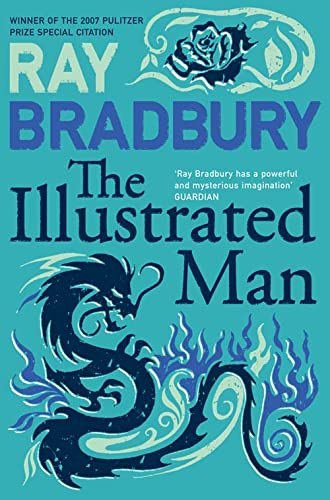
- A fix-up of 16 stories
- First published in 1952
- This edition published by Harper Voyager
- A collection of many genres
- 294 pages
There is a man who wanders the world with disaster and death following in his wake. This man can easily be recognised by his many tattoos. Tattoos that move and change. Tattoos that each have their own story . . .
Let me put this up front. There are short story collections, anthologies, and fix-ups. A collection is the work of a single author. An anthology is the work of multiple authors gathered by an editor. A fix-up is a group of short stories that have been arranged into an overarching narrative. This is all pretty simple, and largely unimportant in the grand scheme of things. But if we’re not being pedantic, are we really science fiction fans? I mention all of this because The Illustrated Man sets itself up as a fix-up, then almost immediately falls over. The narrative conceit employed to connect the stories (which have no other connection) is that all are depicted in the tattoos of a mysterious wanderer. This features in a prologue, an epilogue, and as an insert into one story. Other than that, the framing narrative simply does not exist. Aside from being an incredibly lacklustre link between stories, it doesn’t have any relevance to the stories themselves. It leaves me with one burning question. Why would Ray Bradbury, in all his wisdom and skill, not just drop it all together and leave the stories to stand alone. Probably marketing, but hey ho. On to the stories themselves.
Ray Bradbury is one of those rare science fiction authors who has managed to gain traction in mainstream literature rather than being stomped back into the ghetto of science fiction by overzealous academics. Some of that success comes from the fame of Farenheit 451, but reading these stories, it’s easy to see why. These are stories that place as much focus on the presentation as on the content. Bradbury’s style is incredibly sparse. Even with a large font size, these stories rarely pass twenty pages. The sentences are incredibly simple. The delivery direct. A lot of these stories are not so much narratives as slices of life. And therein lies my dissatisfaction.
Call me a traditionalist, but I’m a big fan of stories in which things happen. Give me a scientific mystery. Give me a challenge. That’s not what you’ll find in The Illustrated Man. The stories here are more about creating mood than posing problems for the characters to overcome. To be fair, they are great at doing this. There’s a sense of loss and tragedy overhanging the whole collection. ‘Kaleidoscope’ sees a crew slowly dying in space as their rocket fails, and is bleak without losing its sense of wonder. ‘The Last Night of the World’ shows a couple dealing with the knowledge that the world is ending, and that all they can do is make their last moments peaceful. Multiple stories relate to nuclear annihilation, but from the perspective of these who survive unharmed. Even in the strongest story in the collection ‘The Long Rain’ the execution of soldiers is described so calmly that any sense of violence is robbed. This a fundamentally serene collection, which makes it different to a lot of others, but does leave the stories lacking in tension.
Bradbury is remembered as one of the USA’s great authors, and I think that might be part of my issue here. Being written in the 1950s, and focusing so much on small American families (in very traditional family units), this is a collection that feels rooted in a culture that I am not a part of. For those who live and grew up in the United States, the social connections will almost certainly hold more weight. But for a Brit like me, it feels more than a little hollow. A pretty enough shell of words, but not enough substance within.
If you enjoyed this book, you might also like:
The Best Science Fiction of Isaac Asimov
The Martian Chronicles, by Ray Bradbury
Judgement Night, by C. L. Moore

